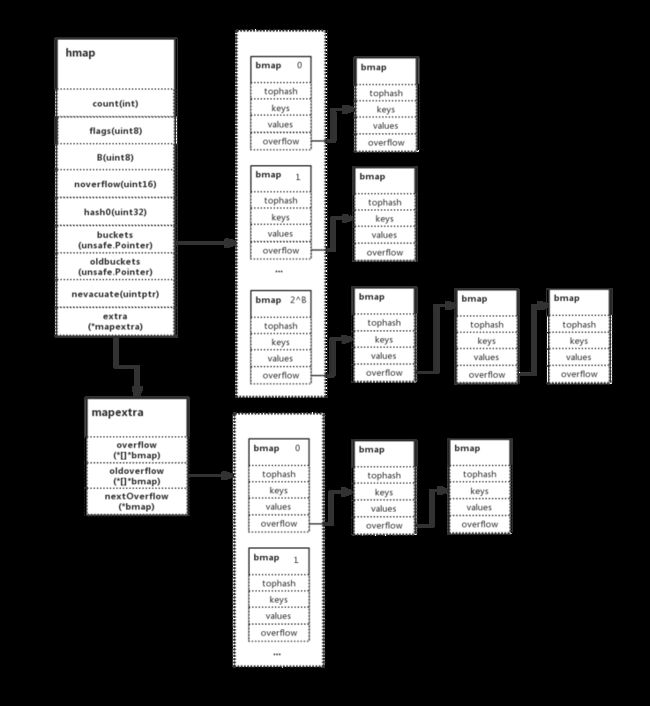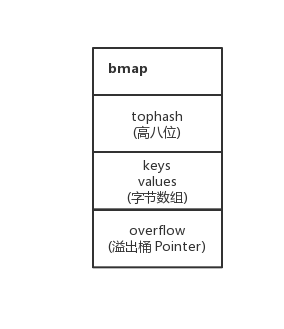从本文开始咱们一起探索 Go map 里面的奥妙吧,看看它的内在是怎么构成的,又分别有什么值得留意的地方?
第一篇将探讨初始化和访问元素相关板块,咱们带着疑问去学习,例如:
- 初始化的时候会马上分配内存吗?
- 底层数据是如何存储的?
- 底层是如何使用 key 去寻找数据的?
- 底层是用什么方式解决哈希冲突的?
- 数据类型那么多,底层又是怎么处理的呢?
...
原文地址:深入理解 Go map:初始化和访问元素
数据结构
首先我们一起看看 Go map 的基础数据结构,先有一个大致的印象
hmap
type hmap struct {
count int
flags uint8
B uint8
noverflow uint16
hash0 uint32
buckets unsafe.Pointer
oldbuckets unsafe.Pointer
nevacuate uintptr
extra *mapextra
}
type mapextra struct {
overflow *[]*bmap
oldoverflow *[]*bmap
nextOverflow *bmap
}- count:map 的大小,也就是 len() 的值。代指 map 中的键值对个数
- flags:状态标识,主要是 goroutine 写入和扩容机制的相关状态控制。并发读写的判断条件之一就是该值
- B:桶,最大可容纳的元素数量,值为 负载因子(默认 6.5) * 2 ^ B,是 2 的指数
- noverflow:溢出桶的数量
- hash0:哈希因子
- buckets:保存当前桶数据的指针地址(指向一段连续的内存地址,主要存储键值对数据)
- oldbuckets,保存旧桶的指针地址
- nevacuate:迁移进度
-
extra:原有 buckets 满载后,会发生扩容动作,在 Go 的机制中使用了增量扩容,如下为细项:
-
overflow为hmap.buckets(当前)溢出桶的指针地址 -
oldoverflow为hmap.oldbuckets(旧)溢出桶的指针地址 -
nextOverflow为空闲溢出桶的指针地址
-
在这里我们要注意几点,如下:
- 如果 keys 和 values 都不包含指针并且允许内联的情况下。会将 bucket 标识为不包含指针,使用 extra 存储溢出桶就可以避免 GC 扫描整个 map,节省不必要的开销
- 在前面有提到,Go 用了增量扩容。而
buckets和oldbuckets也是与扩容相关的载体,一般情况下只使用buckets,oldbuckets是为空的。但如果正在扩容的话,oldbuckets便不为空,buckets的大小也会改变 - 当
hint大于 8 时,就会使用*mapextra做溢出桶。若小于 8,则存储在 buckets 桶中
bmap
bucketCntBits = 3
bucketCnt = 1 << bucketCntBits
...
type bmap struct {
tophash [bucketCnt]uint8
}- tophash:key 的 hash 值高 8 位
- keys:8 个 key
- values:8 个 value
- overflow:下一个溢出桶的指针地址(当 hash 冲突发生时)
实际 bmap 就是 buckets 中的 bucket,一个 bucket 最多存储 8 个键值对
tophash
tophash 是个长度为 8 的数组,代指桶最大可容纳的键值对为 8。
存储每个元素 hash 值的高 8 位,如果 tophash [0] tophash [0] 表示为迁移进度
keys 和 values
在这里我们留意到,存储 k 和 v 的载体并不是用 k/v/k/v/k/v/k/v 的模式,而是 k/k/k/k/v/v/v/v 的形式去存储。这是为什么呢?
map[int64]int8在这个例子中,如果按照 k/v/k/v/k/v/k/v 的形式存放的话,虽然每个键值对的值都只占用 1 个字节。但是却需要 7 个填充字节来补齐内存空间。最终就会造成大量的内存 “浪费”
但是如果以 k/k/k/k/v/v/v/v 的形式存放的话,就能够解决因对齐所 "浪费" 的内存空间
因此这部分的拆分主要是考虑到内存对齐的问题,虽然相对会复杂一点,但依然值得如此设计
overflow
可能会有同学疑惑为什么会有溢出桶这个东西?实际上在不存在哈希冲突的情况下,去掉溢出桶,也就是只需要桶、哈希因子、哈希算法。也能实现一个简单的 hash table。但是哈希冲突(碰撞)是不可避免的...
而在 Go map 中当 hmap.buckets 满了后,就会使用溢出桶接着存储。我们结合分析可确定 Go 采用的是数组 + 链地址法解决哈希冲突
初始化
用法
m := make(map[int32]int32)函数原型
通过阅读源码可得知,初始化方法有好几种。函数原型如下:
func makemap_small() *hmap
func makemap64(t *maptype, hint int64, h *hmap) *hmap
func makemap(t *maptype, hint int, h *hmap) *hmap- makemap_small:当
hint小于 8 时,会调用makemap_small来初始化 hmap。主要差异在于是否会马上初始化 hash table - makemap64:当
hint类型为 int64 时的特殊转换及校验处理,后续实质调用makemap - makemap:实现了标准的 map 初始化动作
源码
func makemap(t *maptype, hint int, h *hmap) *hmap {
if hint < 0 || hint > int(maxSliceCap(t.bucket.size)) {
hint = 0
}
if h == nil {
h = new(hmap)
}
h.hash0 = fastrand()
B := uint8(0)
for overLoadFactor(hint, B) {
B++
}
h.B = B
if h.B != 0 {
var nextOverflow *bmap
h.buckets, nextOverflow = makeBucketArray(t, h.B, nil)
if nextOverflow != nil {
h.extra = new(mapextra)
h.extra.nextOverflow = nextOverflow
}
}
return h
}- 根据传入的
bucket类型,获取其类型能够申请的最大容量大小。并对其长度make(map[k]v, hint)进行边界值检验 - 初始化 hmap
- 初始化哈希因子
- 根据传入的
hint,计算一个可以放下hint个元素的桶B的最小值 - 分配并初始化 hash table。如果
B为 0 将在后续懒惰分配桶,大于 0 则会马上进行分配 - 返回初始化完毕的 hmap
在这里可以注意到,(当 hint 大于等于 8 )第一次初始化 map 时,就会通过调用 makeBucketArray 对 buckets 进行分配。因此我们常常会说,在初始化时指定一个适当大小的容量。能够提升性能。
若该容量过少,而新增的键值对又很多。就会导致频繁的分配 buckets,进行扩容迁移等 rehash 动作。最终结果就是性能直接的下降(敲黑板)
而当 hint 小于 8 时,这种问题相对就不会凸显的太明显,如下:
func makemap_small() *hmap {
h := new(hmap)
h.hash0 = fastrand()
return h
}图示
访问
用法
v := m[i]
v, ok := m[i]函数原型
在实现 map 元素访问上有好几种方法,主要是包含针对 32/64 位、string 类型的特殊处理,总的函数原型如下:
mapaccess1(t *maptype, h *hmap, key unsafe.Pointer) unsafe.Pointer
mapaccess2(t *maptype, h *hmap, key unsafe.Pointer) (unsafe.Pointer, bool)
mapaccessK(t *maptype, h *hmap, key unsafe.Pointer) (unsafe.Pointer, unsafe.Pointer)
mapaccess1_fat(t *maptype, h *hmap, key, zero unsafe.Pointer) unsafe.Pointer
mapaccess2_fat(t *maptype, h *hmap, key, zero unsafe.Pointer) (unsafe.Pointer, bool)
mapaccess1_fast32(t *maptype, h *hmap, key uint32) unsafe.Pointer
mapaccess2_fast32(t *maptype, h *hmap, key uint32) (unsafe.Pointer, bool)
mapassign_fast32(t *maptype, h *hmap, key uint32) unsafe.Pointer
mapassign_fast32ptr(t *maptype, h *hmap, key unsafe.Pointer) unsafe.Pointer
mapaccess1_fast64(t *maptype, h *hmap, key uint64) unsafe.Pointer
...
mapaccess1_faststr(t *maptype, h *hmap, ky string) unsafe.Pointer
...- mapaccess1:返回
h[key]的指针地址,如果键不在map中,将返回对应类型的零值 - mapaccess2:返回
h[key]的指针地址,如果键不在map中,将返回零值和布尔值用于判断
源码
func mapaccess1(t *maptype, h *hmap, key unsafe.Pointer) unsafe.Pointer {
...
if h == nil || h.count == 0 {
return unsafe.Pointer(&zeroVal[0])
}
if h.flags&hashWriting != 0 {
throw("concurrent map read and map write")
}
alg := t.key.alg
hash := alg.hash(key, uintptr(h.hash0))
m := bucketMask(h.B)
b := (*bmap)(add(h.buckets, (hash&m)*uintptr(t.bucketsize)))
if c := h.oldbuckets; c != nil {
if !h.sameSizeGrow() {
// There used to be half as many buckets; mask down one more power of two.
m >>= 1
}
oldb := (*bmap)(add(c, (hash&m)*uintptr(t.bucketsize)))
if !evacuated(oldb) {
b = oldb
}
}
top := tophash(hash)
for ; b != nil; b = b.overflow(t) {
for i := uintptr(0); i < bucketCnt; i++ {
if b.tophash[i] != top {
continue
}
k := add(unsafe.Pointer(b), dataOffset+i*uintptr(t.keysize))
if t.indirectkey {
k = *((*unsafe.Pointer)(k))
}
if alg.equal(key, k) {
v := add(unsafe.Pointer(b), dataOffset+bucketCnt*uintptr(t.keysize)+i*uintptr(t.valuesize))
if t.indirectvalue {
v = *((*unsafe.Pointer)(v))
}
return v
}
}
}
return unsafe.Pointer(&zeroVal[0])
}- 判断 map 是否为 nil,长度是否为 0。若是则返回零值
- 判断当前是否并发读写 map,若是则抛出异常
- 根据 key 的不同类型调用不同的 hash 方法计算得出 hash 值
- 确定 key 在哪一个 bucket 中,并得到其位置
- 判断是否正在发生扩容(h.oldbuckets 是否为 nil),若正在扩容,则到老的 buckets 中查找(因为 buckets 中可能还没有值,搬迁未完成),若该 bucket 已经搬迁完毕。则到 buckets 中继续查找
- 计算 hash 的 tophash 值(高八位)
- 根据计算出来的 tophash,依次循环对比 buckets 的 tophash 值(快速试错)
- 如果 tophash 匹配成功,则计算 key 的所在位置,正式完整的对比两个 key 是否一致
- 若查找成功并返回,若不存在,则返回零值
在上述步骤三中,提到了根据不同的类型计算出 hash 值,另外会计算出 hash 值的高八位和低八位。低八位会作为 bucket index,作用是用于找到 key 所在的 bucket。而高八位会存储在 bmap tophash 中
其主要作用是在上述步骤七中进行迭代快速定位。这样子可以提高性能,而不是一开始就直接用 key 进行一致性对比
图示
总结
在本章节,我们介绍了 map 类型的以下知识点:
- map 的基础数据结构
- 初始化 map
- 访问 map
从阅读源码中,得知 Go 本身对于一些不同大小、不同类型的属性,包括哈希方法都有编写特定方法去运行。总的来说,这块的设计隐含较多的思路,有不少点值得细细品尝 :)
注:本文基于 Go 1.11.5






